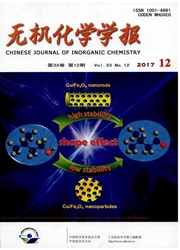

 中文摘要:
中文摘要:
以氮掺杂碳纳米管(NCNT)为载体,利用掺杂氮原子的锚定作用,通过微波辅助乙二醇还原法方便地将Pt纳米粒子高分散地固载于NCNT表面,制得了Pt/NCNT系列催化剂,对催化剂制备规律、电催化甲醇氧化反应(MOR)性能及构效关系开展了系统深入的研究。结果表明,随Pt负载量在18.2%~58.7%(w/w,下同)范围增加,Pt纳米粒子的粒径在2.2~3.7 nm范围相应地逐渐增大。单位质量催化剂的MOR催化活性先增加后急剧减小,在负载量为47.8%时达到最大。Pt的质量比活性在中等负载量(27.6%~47.8%)区间出现高值平台。该变化规律源于Pt纳米粒子的MOR催化活性在3 nm前后的明显差异,即〈3 nm时活性差,〉3 nm时活性优异。高负载量(58.7%)时活性的急剧下降源于Pt纳米粒子因团聚引起的Pt利用率的降低。
 英文摘要:
英文摘要:
Nitrogen-doped carbon nanotubes (NCNT) with N-content of 3%~5%(w/w) and specific surface area of 235 m2. g-1 were used as support for the immobilization of Pt nanoparticles. Pt nanoparticles were highly dispersed on NCNT without needing pre-modification of the support by taking advantage of the inherent chemical activity of NCNT arising from the N-incorporation. A series Of Pt/NCNT catalysts with the loadings of 18.2%~58.7%(w/w, the same below) were conveniently prepared via the microwave-assisted polyol reduction. With increasing Pt loading, the average sizes of Pt nanoparticles increase slightly from 2.2 to 3.7 nm. The mass activity for MOR first increases and reaches the maximum at Pt loading of 47.8%, then decreases dramatically, while the activity based on the Pt mass presents a high-value platform in the Pt-loading range of 27.6%~47.8%. Such a changing tendency is well correlated with the remarkable difference of MOR activity for Pt nanoparticles with the sizes smaller and larger than 3 nm, respectively. The dramatic activity deterioration for the catalyst with high Ptloading of 58.7% comes from the serious agglomeration of Pt nanoparticles, leading to poor Pt utilization.
 同期刊论文项目
同期刊论文项目
 同项目期刊论文
同项目期刊论文
 期刊信息
期刊信息
